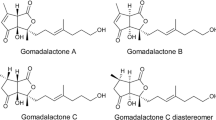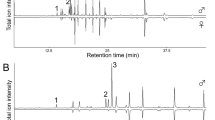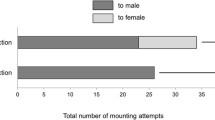Abstract
MaleGrapholitha molesta hairpencil components are ethyltrans-cinnamate, mellein, methyl jasmonate, and methyl 2-epijasmonate. The natural behavioral effect elicited by hairpencil-displaying males during courtship in attracting sex-pheromone-releasing females from several centimeters away can be duplicated by mixtures of ethyltrans-cinnamate in various combinations with the other components.
Similar content being viewed by others
Reference
Aldridge, D.C., Galt, S., Giles, D., andTurner, W.B. 1971. Metabolites ofLasiodiplodia theobromae.J. Chem. Soc. C:1971:1623–1627.
Aplin, R.T., andBirch, M.C. 1970. Identification of odorous compounds from male Lepidoptera.Experientia 26:1193–1194.
Arakawa, H., Torimoto, N., andMasui, Y. 1969. Bestimmung der absoluten konfiguration von Agrimonolid unt Mellein.Liebigs Ann. Chem. 728:152–157.
Baker, T.C., andCardé, R.T. 1979. Courtship behavior of the Oriental fruit moth (Grapholitha molesta): Experimental analysis and consideration of the role of sexual selection in the evolution of courtship pheromones in the Lepidoptera.Ann. Entomol. Soc. Am. 72:173–188.
Baker, T.C., Nishida, R., andRoelofs, W.L. 1981. Close-range attraction of female Oriental fruit moths to male hairpencils' herbal essence.Science 214:1359–1361.
Barrer, P.M., andHill, R.J. 1980. Insect-oriented locomotor responses by unmated females ofEphestia cautella (Walker) (Lepidoptera: Phycitidae).Internat. J. Inve tebr. Reprod. 2:59–72.
Bestmann, H.J., Vosteowsky, O., andPlatz, H. 1977. Pheromone XII. Mannchenduftstoffe von Noctuiden (Lepidoptera).Experientia 33:874–875.
Birch, M. 1970. Pre-courtship use of abdominal brushes by the nocturnal moth,Phlogophora meticulosa (L.) (Lepidoptera: Noctuidae).Anim. Behav. 18:310–316.
Birch, M. 1971. Intrinsic limitations in the use of electroantennograms to bioassay male pheromones in Lepidoptera.Nature 233:57–58.
Birch, M. 1974. Aphrodisiac pheromones in insects, pp. 115–134, in M.C. Birch, (ed.). Pheromones. Elsevier, New York.
Bjostad, L.B., andRoelofs, W.L. 1980. An inexpensive electronic device for measuring electroantennogram responses to sex pheromone components with a voltmeter.Physiol. Entomol. 5:309–314.
Brand, J.M., Fales, H.M., Sokoloski, F.A., MacConnell, J.G., Blum, M.S., andDuffield, R.M. 1973. Identification of mellein in the mandibular gland secretion of carpenter ants.Life Sci. 13:201–211.
Chow, Y.S., Mayer, M.S., andTumlinson, J.H. 1980. Electroantennogram response ofPlodia interpuctella to its sex pheromone and wing gland extracts.Bull. Inst. Zool. Acad. Sin. 19:27–32.
Clear Water, J.R. 1972. Chemistry and function of a pheromone produced by the male of the southern armywormPseudaletia separata.J. Insect Physiol. 18:781–789.
Cole, R.J., Moore, J.H., Davis, N.D., Kirksey, J.W., andDiener, U.C. 1971. 4-Hydroxymellein: A new metabolite ofAspergillus ochraceus.J. Arg. Food Chem. 19:909–911.
Culvenor, C.C.J., andEdgar, J.A. 1972. Dihydropyrrolizine secretions associated with coremata ofUtethesia moths (family Arctiidae).Experientia 28:627–628.
Dahm, K.H., Meyer, D., Finn, W.E., Reinhold, V., andRoller, H. 1971. The olfactory and auditory mediated sex attraction inAchroia grisella (Fabr.).Naturwissenschaften 58:265–266.
Demole, E., andStall, M. 1962. Synthèses du D,L-jasmonate de méthyle et de deux isomères.Helv. Chim. Acta. 45:692–703.
Edgar, J.A., andCulvenor, C.C. 1975. Pyrrolizidine alkaloids inParsonsia species (family Apocynaceae) which attract danaid butterflies.Experientia 31:1–2.
Edgar, J.A., Culvenor, C.C.J., andRobinson, G.S. 1973. Hairpencil dihydropyrrolizines of Danainae from the New Hebrides.J. Aust. Entomol. Soc. 12:144–150.
Edgar, J.A., Culvenor, C.J., andPliske, T.E. 1976. Isolation of a lactone, structurally related to the esterifying acids of pyrrolizidine alkaloids, from the costal fringes of male Ithomiinae.J. Chem. Ecol. 2:263–270.
Edgar, J.A., Cockrum, P.A., andCarrodus, B.B. 1979. Male scent-organs of the vine mothPhalaenoides glycinae Lew. (Agaristidae).Experientia 35:861–862.
Finn, W.E., andPayne, T.L. 1977. Attraction of greater wax moth females to male-produced pheromones.Southw. Entomol. 2:62–65.
Fukui, H., Koshimizu, K., Yamazaki, Y., andUsuda, S. 1977. Structure of plant growth inhibitors in seeds ofCucurbita pepo L.Agric. Biol. Chem. 41:189–194.
Gothilf, S., andShorey, H.H. 1976. Sex pheromones of Lepidoptera: Examination of the role of male scent brushes in courtship behavior ofTrichoplusia ni.Environ. Entomol. 5:115–119.
Grant, G.G. 1970. Evidence for a male sex pheromone in the noctuid,Trichoplusia ni.Nature 277:1345–1346.
Grant, G.G. 1971. Electroantennogram responses to the scent brush secretions of several male moths.Ann. Entomol. Soc. Am. 64:1428–1431.
Grant, G.G. 1974. Male sex pheromone from the wing glands of the Indian meal moth,Plodia interpunctella (Hbn.) (Lepidoptera: Phycitidae).Experientia 30:917.
Grant, G.G. 1976. Courtship behavior of a phycitid moth,Vitula edmandsae.Ann. Entomol. Soc. Am. 69:445–449.
Grant, G.G., Brady, U.E., andBrand, J.M. 1972. Male armyworm scent brush secretion: indentification and electroantennogram study of major components.Ann. Entomol. Soc. Am. 65:1224–1227.
Grula, J.W., McChesney, J.D., andTaylor, O.R. 1980. Aphrodisiac pheromones of the sulfur butterfliesColias eurtheme andC. philodice (Lepidoptera, Pieridae).J. Chem. Ecol. 6:241–256.
Hirai, K. 1977. Observations on the function of male scent brushes and mating behavior inLeucania separata W. andMamestra brassicae L. (Lepidoptera: Noctuidae).Appl. Entomol. Zool. 12:347–351.
Honda, K. 1980. Odor of a papilionid butterfly: Odoriferous substances emitted byAtrophaneura alcinous alcinous (Lepidoptera: Papilionidae)J. Chem. Ecol. 6:867–873.
Jacobson, M., Adler, V.E., Kishaba, A.N., andPriesner, E. 1976. 2-Phenylethanol, a presumed sexual stimulant produced by the male cabbage looper moth,Trichoplusia ni.Experientia 32:964–966.
Lundgren, L., andBergstrom, G. 1975. Wing scents and scent-released phases in the courtship behavior ofLycaedies argyrognomon (Lepidoptera: Lycaenidae).J. Chem. Ecol. 1:399–412.
Meinwald, J., Meinwald, Y.C., Wheeler, J.W., Eisner, T., andBrower, L.P. 1966. Major components in the exocrine secretion of a male butterfly (Lycorea).Science 151:583–585.
Meinwald, J., Meinwald, Y.C., andMazzocchi, P.H. 1969. Sex pheromone of the queen butterfly: Chemistry.Science 164:1174–1175.
Meinwald, J., Thompson, W.R., andEisner, T. 1971. Pheromones. VII. African monarch: Major components of the hairpencil secretion.Tetrahedron Lett. 38:3485–3488.
Meinwald, J., Boriack, C.J., Schneider, D., Boppre, M., Wood, W.F., andEisner, T. 1974. Volatile ketones in the hairpencil secretion of danaid butterflies (Amauris andDanaus).Experientia 32:721–722.
Myers, J., andBrower, L. 1969. A behavioral analysis of the courtship pheromone receptors of the queen butterfly,Danaus gilippus berenice.J. Insect Physiol. 15:2117–2130.
Nishikawa, E., 1933. Biochemistry of molds. II. A metabolic product ofAspergillus melleus Yukawa.J. Arg. Chem. Soc. Jpn. 9:772–774.
Patterson, E.L., Andres, W.W., andBohonos, N. 1966. Isolation of the optical antipode of mellein from an unidentified fungus.Experientia 22:209–210.
Payne, T.L., andFinn, W.E. 1977. Pheromone receptor system in the females of the greater wax mothGalleria mellonella.J. Insect Physiol. 23:879–881.
Petty, R.L., Boppre, M., Schneider, D., andMeinwald, J. 1977. Identification and localization of volatile hairpencil components in maleAmauris ochlea butterflies (Danaidae).Experientia 33:1324–1326.
Ono, T. 1979. Brush organs of the potato tuber moth: Morphology, histology and preliminary examination of its function.Appl. Entomol. Zool. 14:432–437.
Pliske, T.E. 1975. Courtship behavior of the monarch butterfly.Ann. Entomol. Soc. Am. 68:143–151.
Pliske, T.E., andEisner, T. 1969. Sex pheromone of the queen butterfly: Biology.Science 164:1170–1172.
Roelofs, W. 1977. The scope and limitation of the electroantennogram technique in identifying pheromone components, p. 147,in N.R. McFarlane (ed.). Crop Protection Agents—Their Biological Evaluation. Academic Press, New York.
Rotowski, R.L. 1977. Chemical communication in the courtship of the small sulphur butterflyEurema lisa (Lepidoptera, Pieridae).J. Comp. Physiol. 115:75–85.
Rutowski, R.L. 1980. Male scent-producing structures inColias butterflies: Function, localization, and adaptive features.J. Chem. Ecol. 6:13–26.
Schneider, D., andSeibt, U. 1969. Sex pheromone of the queen butterfly: Electroantennogram responses.Science 164:1173–1174.
Tanaka, H., andTorii, S. 1975. Synthesis of methyldl-jasmonate and methyldl-2-epijasmonate.J. Org. Chem. 40:462–465.
Thibout, E. 1978. Role des pheromones males et des corema dans la comportement sexuel precopulatoire d'Acrolepsis (Acrolepia)assectella Zell. (Hyponomeutoidea).C.R. Acad. Sci. Paris 287:1141–1144.
Weatherston, J., andPercy, J.E. 1977. Pheromones in male Lepidoptera, pp. 295–307,in K.G. Adiyodi, and R.G. Adiyodi, (eds.). Advances in Invertebrate Reproduction I. Peralam-Kenoth, Karivellur, Kerala, India.
Wittig, G., andHaag, W. 1955. Uber triphenyl-phosphomethylene als olefinbildende Reagenzien (II. Mitteil).Leibigs Ann. Chem. 88:1654–1666.
Yabuta, T., andSumiki, Y. 1933 Ochracin, a new metabolic product ofAspergillus ochraceus.J. Agr. Chem. Soc. Jn. 9:1264–1275.
Author information
Authors and Affiliations
Additional information
Lepidoptera: Tortricidae.
Supported in part by National Science Foundation grant PCM 78-13241.
Rights and permissions
About this article
Cite this article
Nishida, R., Baker, T.C. & Roelofs, W.L. Hairpencil pheromone components of male oriental fruit moths,Grapholitha molesta . J Chem Ecol 8, 947–959 (1982). https://doi.org/10.1007/BF00987661
Received:
Issue Date:
DOI: https://doi.org/10.1007/BF00987661




